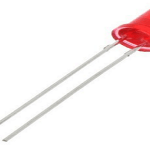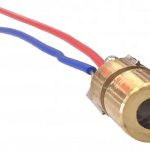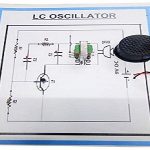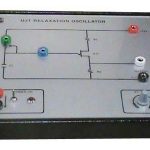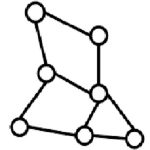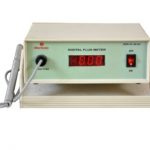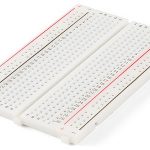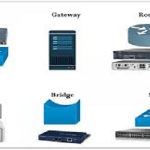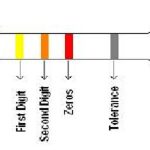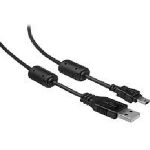At present, one of the latest inventions in diodes is an LED or light-emitting diode. These light bulbs are used almost everywhere from cell phones to large display boards. Day by day, its popularity & its usage is increasing rapidly because of some extraordinary properties. In particular, light-emitting diodes are extremely small in size & consume less power. Generally, light-emitting diodes are active semiconductor-type electronic components. As compared to a normal diode, an LED is … [Read more...]
What is Laser Diode – Construction & Its Working
In present photonics technology, LASER diodes play an essential role. The term LASER stands for “Light Amplification by Stimulated Emission of Radiation". A Laser Diode is a p-n junction diode that emits laser radiation once the current is applied in forward direction. These diodes operate on the optical & electrical properties of semiconductor materials & PN junctions. The process used to emit coherent light in this diode is stimulated emission whereas, in light-emitting diodes, the … [Read more...]
What is LC Oscillator : Circuit & Its Working
In an AC circuit including an inductor & a capacitor, the current and the phase of the voltage are usually different. If you change the circuit components or the power frequency, then the whole circuit will appear simply resistive. Once the LC circuit reaches this condition, then it is known as resonance. In this condition, the circuit reaches the whole impedance or high value. The main essence of resonance is that the energy of the magnetic field within the inductance & the energy of … [Read more...]
What is UJT Relaxation Oscillator & Its Working
A three-terminal semiconductor device like UJT (uni-junction transistor) exhibits different characteristics like switching and negative resistance to using as a relaxation oscillator within phase control applications. This type of transistor can also be used in timing, trigger generator, and gate pulse applications. Similar to diodes, the construction of UJT can be done by using separate P-type & N-type semiconductor materials to form a single PN junction in the main N-type conducting … [Read more...]
What is Nodal Analysis : Differences & Its Examples
In designing electrical circuits, the process of analyzing the circuit is a crucial part, which deals with voltage and current at each branch or node of the circuit. The process of analyzing the circuit is nothing but finding out the unknown voltage and current values of a branch or node. However, this process is complex because more components are connected together in the circuit. Hence the proper technique should be followed to determine the current and voltage. There are two possible … [Read more...]
What is a Flux Meter : Construction & Its Working
In electromagnetism, magnetic flux is defined as the number of magnetic lines of forces observed at the surface of a magnetic material. Magnetic flux is denoted with 'Φ'. The SI unit of magnetic flux is derived as volt-seconds, also known as Weber and Maxwell as CGS unit. To measure the amount of flux generated from a magnetic surface an instrument called 'Fluxmeter' is used. Fluxmeter consists of measuring coils placed between permanent magnets known as Helmholtz coil arrangement. The change in … [Read more...]
What is a Breadboard : Construction & Its Working
In the initial days of electronics manufacturing, engineers and designers have realized that sometimes designing a temporary circuit needs without soldering the components. So, an engineer took cardboard and arranged several rows into it to place nails. As per the circuit diagram, they placed components and nailed them through short wire pieces. The electrical connection can be provided by wrapping wire or soldering around the nails, and then components could be soldered to the wires. But by … [Read more...]
What are Network Devices : Types & Their Working
The development of computer networking started with the progress of Arpanet in the period of the ending of the 1960s and in the initial stages of the 1970s. Before the networking devices, there were computer vendor networks which are mainly constructed to associate connection between terminals and remote job entry locations with that of the mainframe. Whereas the crucial thought behind the networking was to accomplish network sharing and it was the basis in the ARPANET design. It is even more … [Read more...]
What is a Resistor Color Code & Its Calculation
Resistors are small electrical components, used in several electrical and electronic circuits to restrict the flow of current within the circuit and also to regenerate voltage drop in several ways. These are available in different sizes and shapes. Each resistor includes a resistance or resistive value that ranges from ohms to milliohms. So these values can be measured through the color band concept. For each small component, a color code is used to indicate the resistance value instead of … [Read more...]
What is Ferrite Bead : Types & Its Working
In various electronic circuits, ferrite bead inductors are used as an effective form of filter. A ferrite bead is made up of ferrite material in Halloween cylindrical shape. It is available in small sizes at affordable rates. It is also called a ferrite block, ferrite core or EMI filter, or ferrite choke or ferrite ring that is used to suppress high-frequency noise in the given electronic circuit. The properties of ferrite within the inductor might help to reduce EMI. The high permeability of … [Read more...]
- « Previous Page
- 1
- …
- 10
- 11
- 12
- 13
- 14
- …
- 23
- Next Page »
